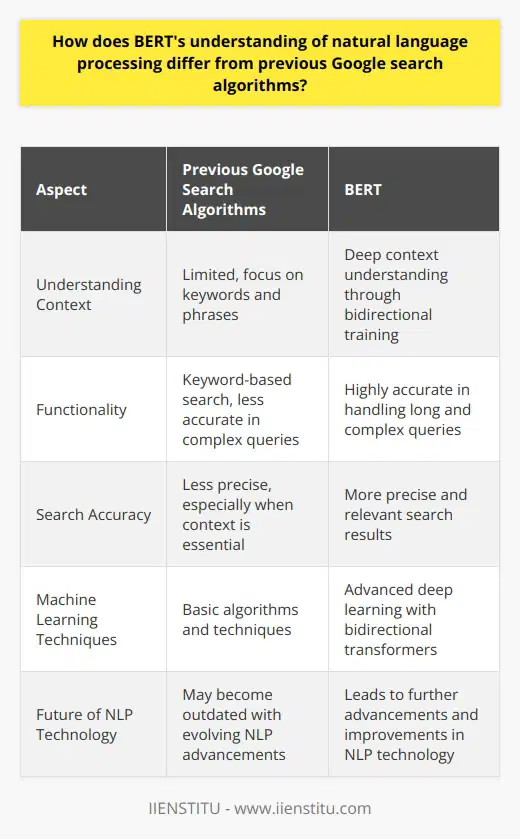
This article explores BERT, a natural language processing (NLP) algorithm developed by Google AI, and its impact on SEO. BERT is designed to understand the context of a given sentence or query and determine the meaning of each word within it. BERT enables Google to analyze words before and after a word or phrase to understand its meaning entirely. It uses a deep learning technique called "transformer" to analyze words within a sentence or query.
BERT has had a significant impact on SEO, enabling Google to understand the context of a query better and provide more accurate search results. This has made it easier for businesses to optimize their content for SEO, as they can target more specific keywords and phrases that are more likely to be understood by Google's algorithm.
Introduction
What is BERT?
How BERT Enhances Google's Language Analysis
The Impact of BERT on SEO
Conclusion
Unlocking SEO with BERT: How Google Analyzes Context
Search engine optimization (SEO) is a critical component of success for any website or online business. SEO involves optimizing content and webpages to rank high in search engine results pages (SERPs). As search engines have evolved, so have the algorithms used to organize content. Google's BERT algorithm is one of the most significant developments in this area. In this article, we will explore what BERT is, how it enhances Google's language analysis, and its impact on SEO.
Introduction: Search engine optimization (SEO) is a critical component of success for any website or online business. SEO involves optimizing content and webpages to rank high in search engine results pages (SERPs). As search engines have evolved, so have the algorithms used to organize content.
Google's BERT algorithm is one of the most significant developments in this area. In this article, we will explore what BERT is, how it enhances Google's language analysis, and its impact on SEO.
What is BERT?
BERT stands for Bidirectional Encoder Representations from Transformers. It is a natural language processing (NLP) algorithm developed by Google AI. BERT is designed to understand the context of a given sentence or query and determine the meaning of each word within it. Before BERT, Google's language analysis could only consider the words before or after a word or a phrase to understand its meaning. BERT enables Google to examine words before and after a word or a phrase to understand its meaning entirely.
For example, BERT enables Google to understand the intended meaning of "2022 brazil traveler to usa need a visa," whereas, before BERT, Google would have assumed that the query was about someone in the US wanting to travel to Brazil (when in fact, the opposite is the case).
How BERT Enhances Google's Language Analysis
BERT uses a deep learning technique called "transformer" to analyze words within a sentence or query. It looks at the context of the terms, rather than just the words themselves, to understand the sentence's meaning. This enables BERT to understand the nuances of language, such as slang and other forms of informal language.
BERT is also capable of understanding the relationships between words and phrases. For example, if a query includes the words "apple" and "iPhone," BERT will know that they are related, even if they are not adjacent. This allows Google to provide more accurate search results.
The Impact of BERT on SEO
BERT has had a significant impact on SEO. It has enabled Google to understand the context of a query better and provide more accurate search results. This has made it easier for businesses to optimize their content for SEO, as they can target more specific keywords and phrases that are more likely to be understood by Google's algorithm.
In addition, BERT has enabled Google to understand the intent behind a query better. This has allowed Google to provide more relevant search results, which has improved the user experience. This has also allowed businesses to target their SEO efforts more effectively, as they can better understand what their customers are searching for and optimize their content accordingly.
Conclusion: Google's BERT algorithm has had a significant impact on SEO. It has enabled Google to understand the context of a query better and provide more accurate search results. This has made it easier for businesses to optimize their content for SEO, as they can target more specific keywords and phrases that are more likely to be understood by Google's algorithm. In addition, BERT has enabled Google to understand better the intent behind a query, which has improved the user experience and allowed businesses to target their SEO efforts more effectively.
Unlocking SEO with BERT is the key to unlocking Google's ability to analyze context.
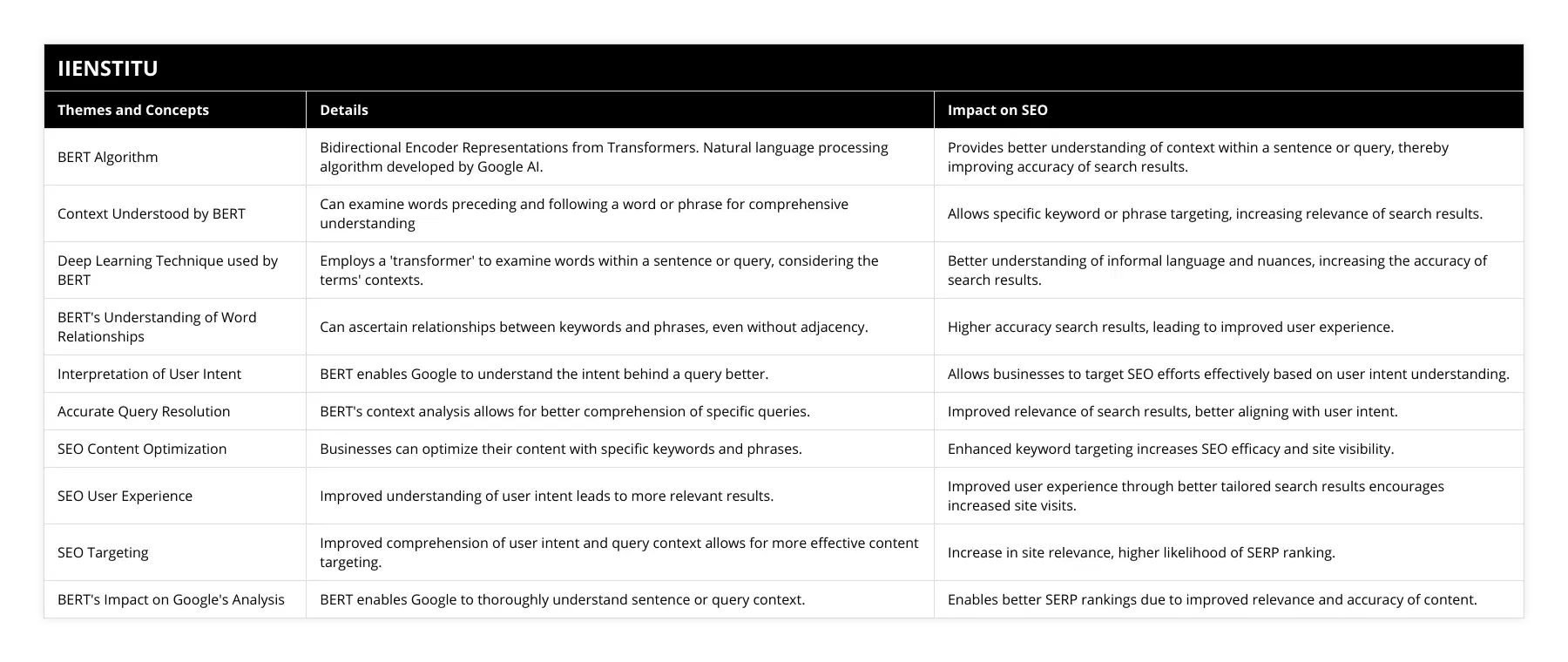
Frequently Asked Questions
What is BERT and how does it enhance Google's language analysis?
BERT (Bidirectional Encoder Representations from Transformers) is an open-source natural language processing (NLP) framework developed by Google. It is a deep learning-based model that uses pre-trained language models to improve the accuracy of predicting the context of a given text. As a result, BERT has significantly improved Google's language analysis capabilities, providing more accurate results than existing language models.
The BERT model is based on the Transformer architecture, which was initially developed to process sequences of words in a bidirectional manner. This means that the model can consider a sentence's context by looking at both the preceding and the following terms. The BERT model also uses masking, which randomly masks out 15% of the words in a sentence and then requires the model to predict the masked words using the context of the sentence. This helps the model better understand a sentence's context and provides more accurate results.
In addition to the Transformer architecture, BERT also uses a technique called pre-training. This involves training the model on a large corpus of text, such as a Wikipedia dump or a set of books, to learn the language. The model is then fine-tuned for tasks such as question answering or sentiment analysis by providing data from the study. This helps the model better understand the job and provides more accurate results.
The use of BERT has resulted in significant improvements in Google's language analysis capabilities. BERT has been used to enhance Google's search engine results, improving the accuracy of the results and providing more relevant results for searches. It has also improved Google's natural language understanding capabilities, enabling it better to comprehend the intent behind a user's query and provide more accurate results.
Overall, BERT has significantly contributed to Google's language analysis capabilities. Using a combination of the Transformer architecture and pre-training, the model can provide more accurate results than existing language models. This has enabled Google to provide more precise search results and better natural language understanding capabilities.

How does BERT impact SEO?
The emergence of BERT (Bidirectional Encoder Representations from Transformers) as part of Google's search algorithm has profoundly impacted Search Engine Optimization (SEO). BERT is a natural language processing (NLP) technique that helps Google better understand the intent behind a search query. By understanding the intent behind a query, BERT can provide a more relevant result to the user, which is beneficial both to the user and to the website or business being searched for.
SEO is becoming increasingly crucial for website owners as search engines become more sophisticated. BERT has changed how SEO is approached since it requires understanding the intent behind a user's search query. This means that SEO must now focus on ranking highly for targeted keywords and providing relevant content that satisfies the user's query.
In addition to optimizing content for the user's query, BERT also looks at the context of a query. For example, if a user queries how to make a cake, BERT can understand that the user is looking for instructions on how to bake a cake, not a recipe for how to make a cake. This allows BERT to return more relevant results to the user, which in turn helps to improve the SEO of the website or business being searched for.
Finally, BERT also considers the intent behind related queries. For example, if a user searches for how to bake a cake, BERT might consider other related queries, such as decorating a cake or cake-baking tips. By understanding associated queries and their intent, BERT can provide more relevant results and improve the SEO of the website or business being searched for.
In summary, BERT has significantly impacted SEO by providing more relevant search results to users. BERT considers various factors to return the most relevant results, including the intent behind a query and related queries. By understanding the user's query and providing relevant content, BERT helps improve the SEO of the website or business searching for.

What are the implications of BERT for SEO?
The emergence of Bidirectional Encoder Representations from Transformers (BERT) has dramatically impacted the field of Natural Language Processing (NLP). In particular, the technology has been applied to the task of Search Engine Optimization (SEO). This article outlines the implications of BERT for SEO, highlighting both the potential benefits and drawbacks of the technology.
In terms of potential benefits, BERT has been instrumental in improving the accuracy of search engine rankings. This is due to its ability to understand search queries' meaning and match them to the most relevant content. In addition, BERT's utilization of contextual data enables it to identify and prioritize high-quality content, resulting in improved search engine performance for users. Furthermore, the use of BERT for SEO can help to reduce the amount of time spent manually optimizing content for SEO purposes.
On the other hand, there are potential drawbacks associated with using BERT for SEO. One of these drawbacks is that BERT is a black box model, meaning that it is difficult to understand the exact impact of BERT on the ranking of content. This makes it difficult to optimize content effectively for SEO purposes, as the same parameters influencing the order are unknown. Additionally, BERT depends on large quantities of data, meaning that smaller websites may struggle to utilize the technology.
In conclusion, BERT has the potential to improve the accuracy of search engine rankings and reduce the time spent manually optimizing content for SEO. However, the technology is a black-box model dependent on extensive data. For these reasons, the implications of BERT for SEO must be carefully considered before implementing the technology.
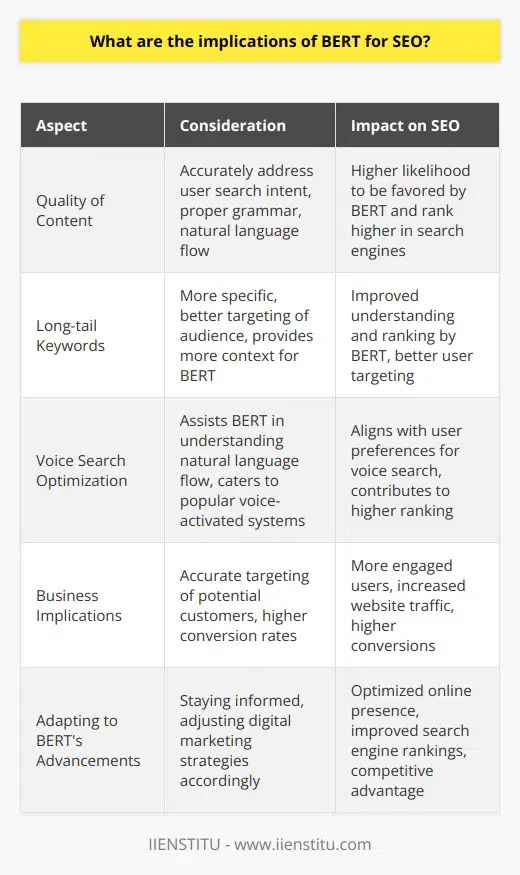
How does the incorporation of BERT influence the understanding of search queries by Google?
BERT's Role in Search Queries
BERT, or Bidirectional Encoder Representations from Transformers, has significantly influenced Google's search query understanding by incorporating natural language processing techniques. This advanced approach to deciphering user inputs allows Google to better interpret the context and intent behind search queries.
Contextual Comprehension
BERT's ability to analyze context derives from its bidirectional nature, enabling it to consider both prior and subsequent words within a given sentence. As a result, search queries containing nuanced phrases or complex semantic relationships become more comprehensible for the search engine. Consequently, Google can provide more accurate and relevant search results tailored to the user's intent.
Handling Ambiguity
One of BERT's notable contributions to search query understanding is its capacity to address linguistic ambiguity. This allows Google to discern meaning from phrases that may be underspecified or contain multiple possible interpretations. By considering the surrounding context, BERT enhances the search engine's ability to accurately process ambiguous words, leading to improved search results.
Long-tail Queries and Rare Words
BERT's incorporation also benefits the understanding of long-tail queries and rare words by capturing word relationships within sentences. These complex queries, which may include uncommon terms or highly specific requests, can now be better understood by the search engine. Additionally, BERT's attention mechanism enables it to weigh the importance of different words within a query, ensuring that rare words are not overlooked.
Improved User Satisfaction
Ultimately, the incorporation of BERT into Google's search query understanding has resulted in increased user satisfaction. By accurately interpreting context, intent, and ambiguity, the search engine can generate more targeted and relevant search results. This not only enhances the overall user experience but also reinforces the importance of continuous advancements in natural language processing and machine learning technologies.
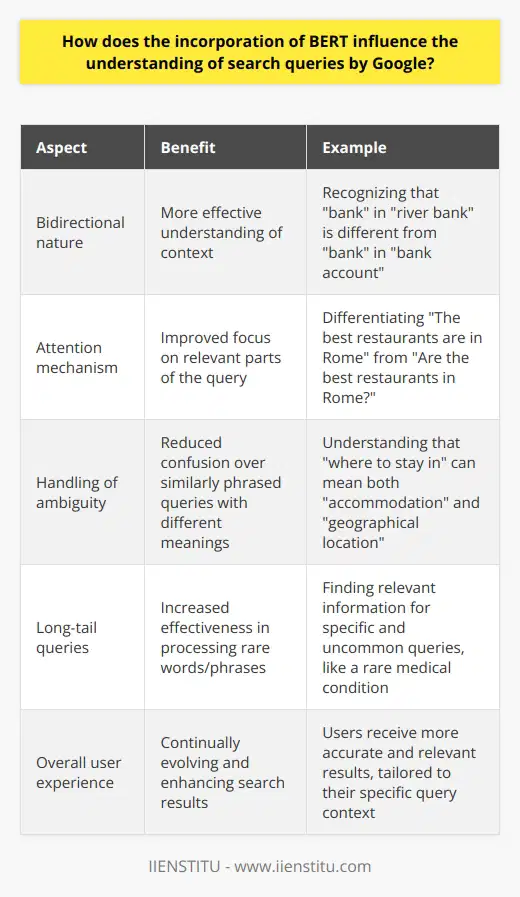
What are the key components of the BERT algorithm that contribute to improved SEO?
**BERT Algorithm's Key Components**
The BERT (Bidirectional Encoder Representations from Transformers) algorithm is a breakthrough in natural language processing that has facilitated remarkable improvements in SEO (Search Engine Optimization). Its key components include bidirectional transformers, pre-training, and fine-tuning processes.
**Bidirectional Transformers**
The first key component, bidirectional transformers, stands out as it allows BERT to understand sentences' context by reading both forwards and backward. This bidirectional approach differs from traditional models that only read text sequentially, lacking the capacity to grasp context from all directions. Consequently, BERT's bidirectionality leads to more accurate and meaningful interpretations of text, ensuring that search engines provide relevant results, thus improving SEO.
**Pre-Training Process**
BERT further owes its SEO success to its intensive pre-training process. In this phase, the algorithm is trained on a massive dataset containing text from sources like Wikipedia and Book Corpus. It learns to predict and fill gaps in sentences by analyzing the context, thus capturing various language relationships. By having this strong foundation, BERT becomes adept at understanding various content types, including text, queries, and websites, enhancing the overall searching experience and ensuring the most relevant content is delivered to users.
**Fine-Tuning Process**
Finally, the fine-tuning process, wherein BERT gets tailored to specific tasks or domains, is another significant contributor to its SEO efficacy. When implemented in search engines, BERT is fine-tuned to focus on website ranking, query understanding, and content relevancy. This adaptability to various domains increases its accuracy in understanding and delivering the most pertinent search results to users, further boosting SEO.
In conclusion, the BERT algorithm's bidirectional transformers, pre-training, and fine-tuning processes are essential components that have revolutionized natural language processing and significantly improved SEO. By understanding the context and relationships within the text in a more sophisticated manner, BERT ensures that search engines provide more relevant and accurate results, enhancing user satisfaction and the overall search experience.
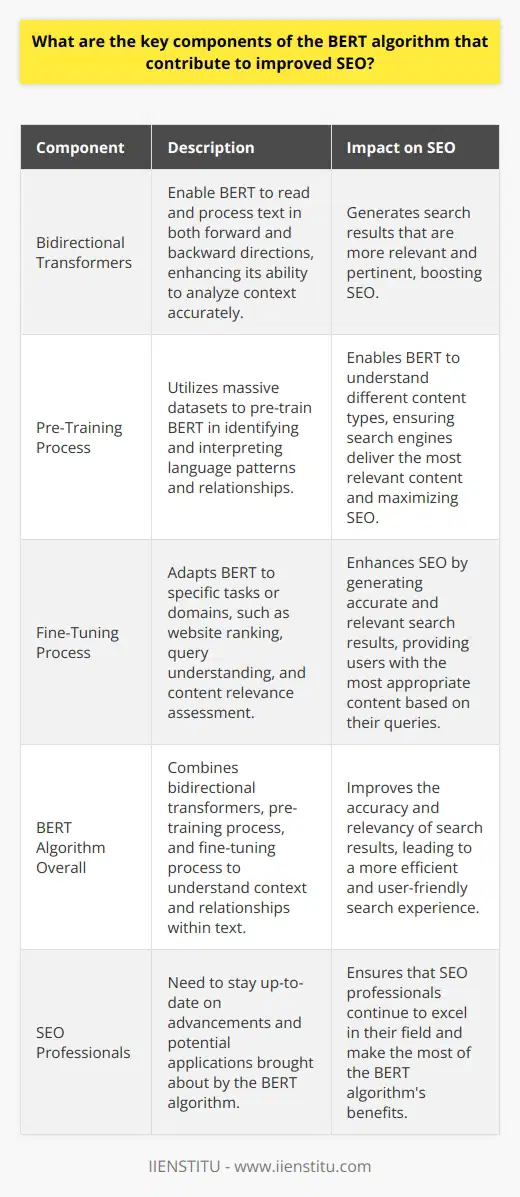
To what extent does the implementation of BERT necessitate adjustments to on-page SEO strategies?
BERT and On-Page SEO Strategies
Understanding BERT's Impact
To evaluate the implications of BERT on on-page SEO strategies, it is imperative to first comprehend its functionality. BERT, or Bidirectional Encoder Representations from Transformers, is an open-source, natural language processing model designed by Google to enhance its search engine's understanding of user queries. This model contributes to better understanding of the context and semantics of search queries by considering the words' relationships, in both their preceding and following sequences. Consequently, it enhances the accuracy and relevance of search results.
SEO Strategies Adjustments
Given BERT's impact on search engine performance, it becomes essential to reevaluate and adjust on-page SEO strategies. A primary adjustment required is the production of high-quality, contextual content that closely adheres to the user's search intent. Descriptive and purposeful content garners greater attention from BERT algorithms, as it focuses on satisfying the user's query, rather than only targeting keywords.
Emphasizing Long-Tail Keywords
Furthermore, BERT's application emphasizes the importance of long-tail keywords in on-page SEO. As BERT is programmed to better understand the context of search queries, utilizing long-tail keywords, comprising more specific and detailed phrases, assists in catering to the user's intent more accurately. Additionally, long-tail keywords encounter lower competition levels, which further contributes to improved search rankings.
Optimizing for Featured Snippets
Another noteworthy adjustment involves optimizing content for featured snippets. As BERT refines its understanding of user queries, featured snippets become increasingly significant for driving organic traffic. Structuring content with clear headings, bullet points, and lists enhances the likelihood of being featured in snippets, resulting in increased visibility and prominence on search engine results pages.
Improving Readability
Lastly, an essential aspect of on-page SEO strategies, accentuated by BERT's implementation, is the focus on improving readability. Utilizing simple vocabulary, shorter sentences, and coherent structure promotes the accessibility of the content, ensuring comprehension among a wider audience pool. Enhancing readability contributes to greater user engagement and is favored by BERT in response to user queries.
In conclusion, BERT's implementation requires substantial adjustments to on-page SEO strategies, as it prioritizes contextual, high-quality content capable of satisfying user search intent. These adjustments include optimizing content, emphasizing long-tail keywords, targeting featured snippets, and enhancing readability to achieve greater search engine ranking and visibility.
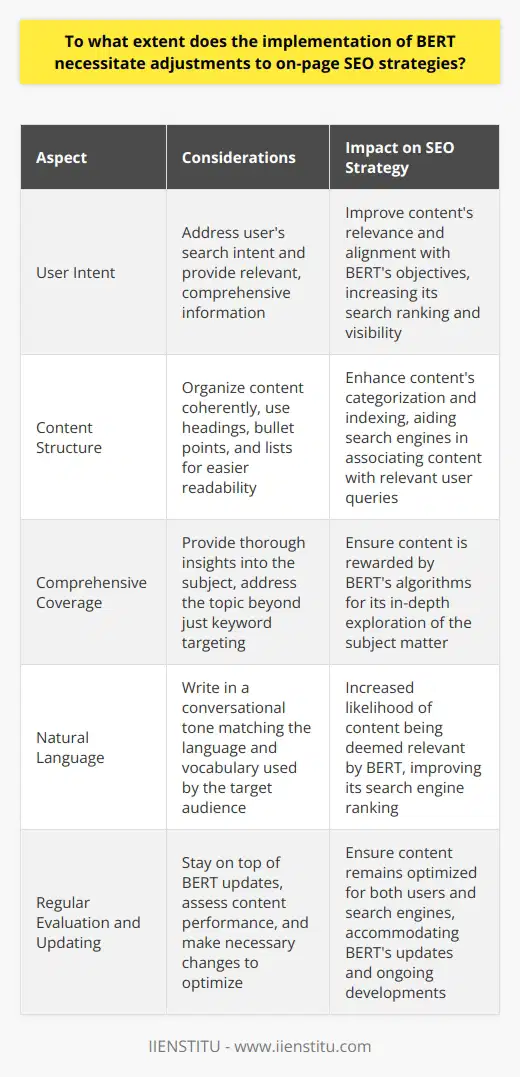
How does BERT look at context?
Contextual Analysis in BERT
Understanding Contextual Representation
BERT, or Bidirectional Encoder Representations from Transformers, revolutionizes the way context is perceived in natural language processing (NLP) tasks. Unlike traditional methods that analyze words in isolation, BERT considers the entire sequence of words to derive contextualized representations.
Bidirectional Language Modeling
The bidirectional mechanism of BERT enables it to examine text from both directions simultaneously. It exploits the masked language model, which randomly masks a percentage of the input words, and then predicts the masked words based on their context. This technique encourages the model to have a deeper understanding of the text's context.
Importance of Pre-training
Before being fine-tuned on a specific task, BERT undergoes a comprehensive pre-training process using two unsupervised techniques: masked language modeling and next sentence prediction. These methods help BERT capture long-range contextual relationships between words in a sentence and enable the model to adapt to various NLP tasks quickly.
Context Embedding Layers
BERT comprises multiple layers of self-attention mechanisms, which aid in capturing contextual information in different levels of abstraction. These layers allow the model to consider the relationships between words in a broader sense, making it highly effective in understanding context.
Semantic Disambiguation
By analyzing context, BERT efficiently tackles the challenge of word sense disambiguation. It excels in understanding polysemous words, or words with multiple meanings, by considering the surrounding text to decide the appropriate meaning of the word in question.
In conclusion, context plays a pivotal role in BERT's groundbreaking success in NLP tasks. Through bidirectional language modeling, pre-training methods, and its multiple self-attention layers, BERT captures the complexities and nuances of language to derive richer contextual representations. This ability to comprehend context with unprecedented accuracy sets BERT apart from its predecessors in the field of natural language processing.
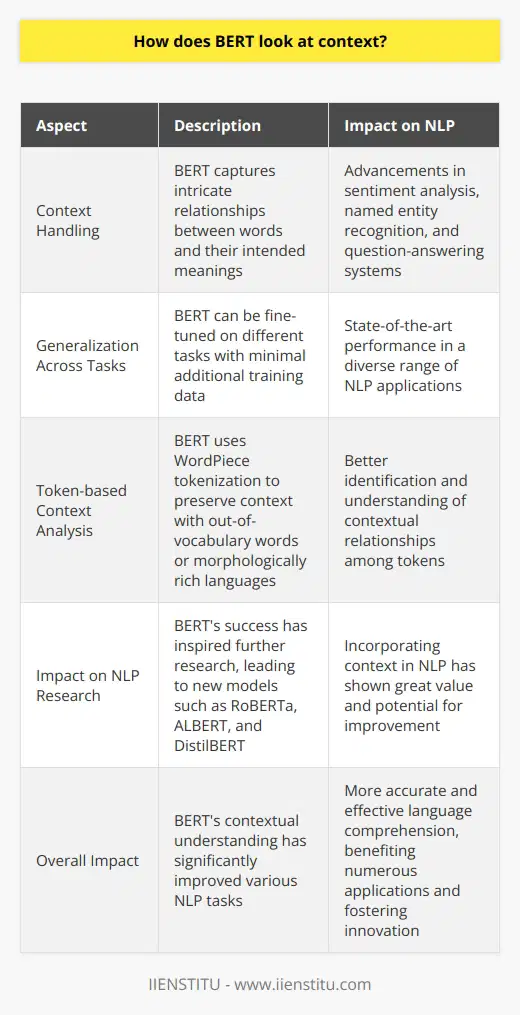
How does Google search use BERT?
**BERT's Role in Google Search**
BERT (Bidirectional Encoder Representations from Transformers) is an advanced machine learning technique that helps Google Search understand the context of search queries. By analyzing both the words preceding and following a given term, BERT grasps the full intent of users' questions.
**Understanding Natural Language**
One primary way Google Search benefits from BERT is through its ability to comprehend natural language in search queries. It does this by examining the relationship between words, thus making sense of the entire phrase or sentence. This ability enables BERT to provide more relevant search results by matching users' intent accurately.
**Search Results Enhancement**
The incorporation of BERT into Google Search significantly improves the quality of search results. It ensures that users receive not only relevant but also helpful information based on their queries. In turn, this enhances user experience and satisfaction with the search engine's performance.
**Handling Complex Queries**
By utilizing BERT to analyze search queries, Google Search can better handle complex or long-worded questions that depend on context for meaning. The ability to extract and comprehend context from a query allows Google Search to provide more accurate search results even for nuanced and sophisticated searches.
**Global Application**
Google has integrated BERT in multiple languages, further extending its ability to provide comprehensive search results to users worldwide. Moreover, it continues to improve BERT models and expand its application to additional languages, thereby enhancing Google Search for a broader audience.
In conclusion, Google Search employs BERT to understand natural language, enhance search results, handle complex queries, and offer a consistent experience across languages. BERT's contextual understanding of search queries enables the search engine to deliver precise, relevant, and helpful results to users globally.
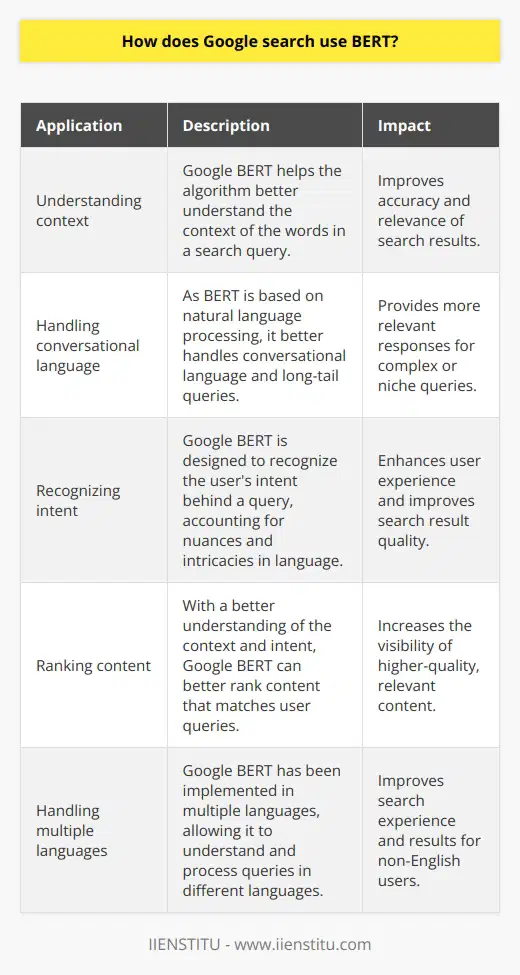
What is the BERT algorithm in SEO?
Introduction to BERT Algorithm
The BERT (Bidirectional Encoder Representations from Transformers) algorithm constitutes a significant development in the field of natural language processing (NLP) and search engine optimization (SEO). Introduced by Google in 2019, this pre-trained deep learning algorithm aims to enhance search engines' understanding of user queries and deliver more relevant search results.
Functionality of BERT
The primary objective of BERT is to better grasp the context and nuances of natural language, particularly regarding the user's search intent. Unlike traditional NLP models that analyze words in a linear sequence, BERT processes input data bidirectionally. This bidirectional analysis allows the algorithm to recognize and interpret the subtle relationships among words and phrases within a query, hence leading to improved understanding and matching.
Impact on SEO
BERT's ability to understand user queries more accurately has considerable implications for SEO. Content creators and website owners must prioritize the production of high-quality, relevant content that directly addresses user intent. Since BERT focuses on context rather than keywords, it is essential to have clear and concise language throughout the content. Additionally, optimizing for long-tail and conversational queries becomes more crucial with voice search and the use of digital assistants on the rise.
Challenges and Limitations
While BERT represents a significant leap in NLP innovation, it is not without its share of limitations. First, as a resource-intensive model, it demands substantial computational power, which may hinder its effectiveness and scalability across multiple languages and contexts. Second, there exists a risk of overfitting while fine-tuning the algorithm to specific tasks. Lastly, BERT remains largely dependent on the quality and diversity of the data it is trained on, potentially leading to biases in its understanding and outputs.
Embracing BERT in SEO Strategies
To adapt to the evolving landscape of SEO with BERT, marketers and content creators must shift their focus from keyword density to addressing user intent explicitly. Utilizing natural language, engaging the audience with contextually relevant content, and incorporating long-tail and conversational keywords will aid in navigating the effects of BERT on search rankings.
In conclusion, the introduction of the BERT algorithm has redefined the approach to SEO and NLP. Leveraging this advanced technology to enhance user experience and search outcomes demands a refocus on contextual relevance, intent-driven content, and user-friendly language. As search engines continue to evolve, keeping abreast of emerging algorithms and adjusting SEO strategies will remain paramount in achieving online visibility and success.
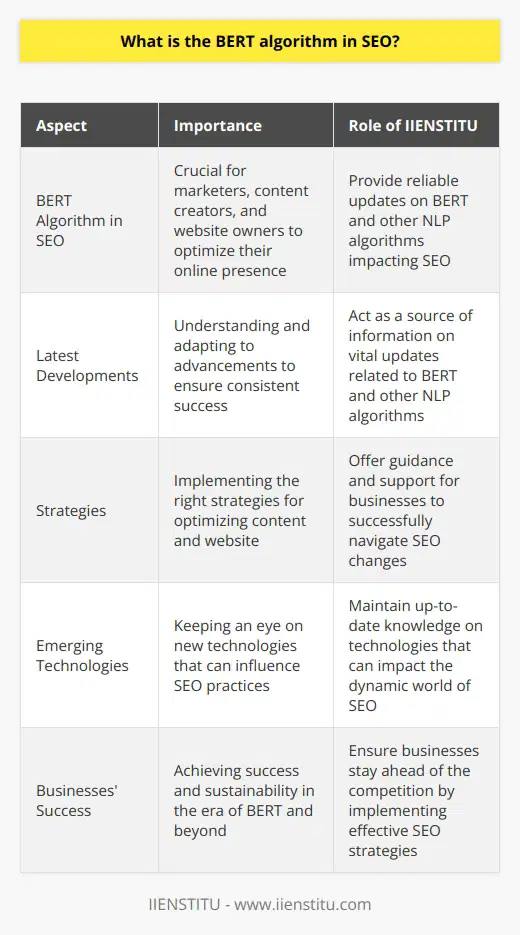
How does BERT contribute to a more accurate understanding of user intent in search queries?
**BERT's Impact on Understanding User Intent**
BERT (Bidirectional Encoder Representations from Transformers) significantly enhances the accuracy of understanding user intent in search queries. This breakthrough technology efficiently addresses the limitations of earlier language models, shedding light on the intricate nature of queries and providing improved search results.
**Contextual Understanding and Bidirectionality**
One of the key aspects of BERT's contribution is its ability to process words in the context of the entire sentence instead of isolated terms. As a result, BERT takes into account the relationship and order of words, which fundamentally aids in understanding the user's true intention. Moreover, by adopting a bidirectional approach, BERT examines both left and right contexts of a word simultaneously, offering a more accurate comprehension of linguistic nuances.
**Handling Ambiguity and Polysemy**
Ambiguity and polysemy often pose challenges in discerning the precise intent of user queries. BERT's ability to effectively identify the appropriate sense of a word within its given context leads to a deeper understanding of user intent. Consequently, BERT can extract the correct meaning of homonyms, adding an advanced level of accuracy to search results.
**Semantic Similarity and Paraphrasing**
BERT further impacts the comprehension of user intent by recognizing the semantic similarity between search queries and available content. This cognitive ability enables the model to detect paraphrasing, ultimately enhancing the search experience by delivering pertinent results even when users utilize diverse phrasing to convey their intent.
**Natural Language Processing Advancements**
In the realm of natural language processing, BERT represents a significant step forward, as it exhibits advanced linguistic abilities that capture the essence of users' intentions. By employing contextualization, bidirectional processing, and semantic understanding, BERT elevates search engines' capacity to discern and respond to intricate queries. The outcome is a superior user experience that accurately aligns with the intent behind each query, leading to improved search results and greater user satisfaction.
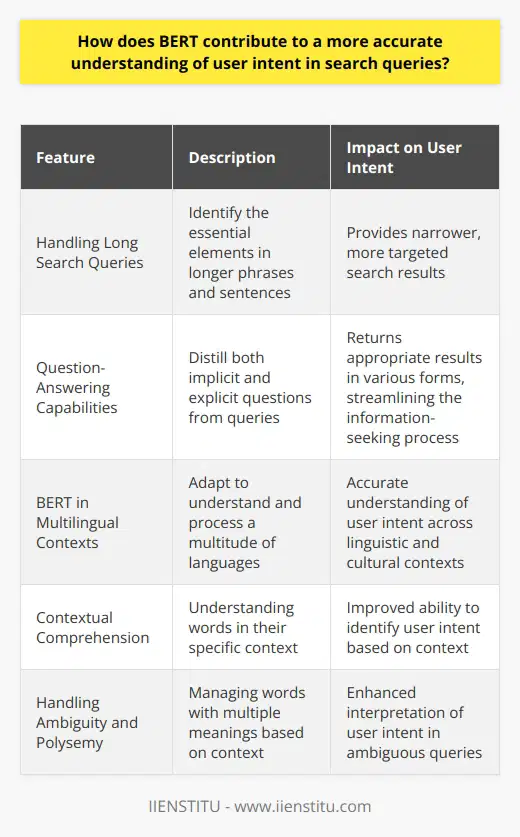
In what ways can webmasters optimize their content to be more compatible with BERT's semantic analysis?
Understanding BERT's Semantic Analysis
To optimize content for BERT's (Bidirectional Encoder Representations from Transformers) semantic analysis, webmasters must first understand how the algorithm processes text. BERT is a natural language processing (NLP) technique that focuses on context and semantic understanding. It analyzes entire sentences rather than individual words, so webmasters should optimize their content by focusing on contextual information and sentence structure.
Writing Clear and Concise Sentences
To ensure compatibility with BERT's semantic analysis, webmasters should write clear and concise sentences that convey precise meaning. Overly complex sentence structures or ambiguous phrasing may lead to misinterpretation by BERT. By keeping sentences short (ideally, no more than 20 words) and using straightforward language, webmasters can improve both the readability of their content for human users and the compatibility with BERT's analysis.
Using Relevant and Specific Examples
Another way to maximize compatibility with BERT's semantic analysis is to use relevant and specific examples in the content. These examples should be closely related to the primary topic, helping BERT understand the context and focus of the content. Including relevant examples can also increase user engagement, as they provide additional value and understanding to readers.
Emphasizing Long-Tail Keywords
BERT's focus on context benefits webmasters in optimizing long-tail keywords, which are typically more specific and less competitive than broad keywords. Webmasters should identify high-value, relevant long-tail keywords for their content, ensuring that these keywords are used within a natural and meaningful context. This approach not only demonstrates the content's relevance to users but also aligns with BERT's emphasis on understanding the overall context of a text.
Implementing Structured Data
When appropriate, webmasters can implement structured data, such as schema markup, to provide explicit context and meaning to their content. Structured data formats, like JSON-LD, allow webmasters to describe specific elements on a page, such as author, publication date, or product information, and make this information easily accessible to search engines. By providing additional context, structured data helps BERT understand and process the semantic meaning of content more efficiently.
In conclusion, optimizing content for BERT's semantic analysis requires webmasters to consider various elements of their content, including clear sentence structure, long-tail keywords, and structured data. By focusing on creating contextually rich and semantically informative content, webmasters can improve their compatibility with BERT, increasing their chances of being ranked higher on search engine results pages.
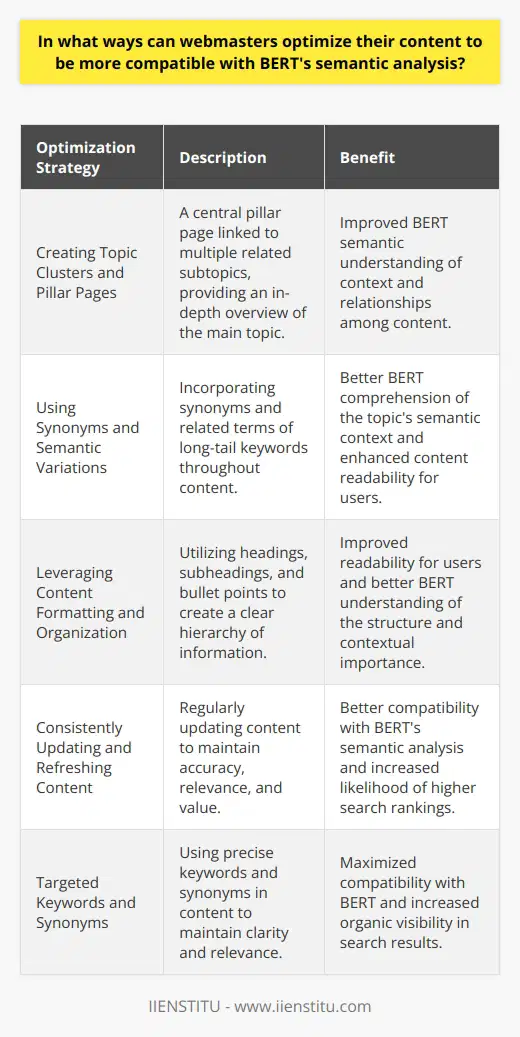
Has the introduction of BERT resulted in any significant changes to search engine result pages (SERPs)?
Impact of BERT on SERPs
Understanding the BERT Model
BERT (Bidirectional Encoder Representations from Transformers) has been a significant development in natural language processing (NLP). As a deep learning model, it understands the complex relationships between words and can process multiple languages. By comprehending the context of phrases effectively, BERT improves the quality of search engine result pages (SERPs).
Search Relevance and User Intent
With the introduction of BERT, search engines now feature better alignment between search queries and relevant results. The improved NLP capabilities enable search engines to comprehend user intent more accurately. Consequently, the SERPs have become more focused on providing answers that genuinely match users' expectations.
Long-tail Keywords and Search Results
One notable change brought about by BERT is in the handling of long-tail keywords - longer and more specific search queries. Historically, search engines struggled to deal with these queries effectively. However, BERT's deep understanding of language allows it to process long-tail keywords more efficiently, producing more accurate search results for users.
Localization and Multilingual SERPs
As BERT supports multiple languages, it has greatly influenced the quality and relevance of SERPs for non-English searches. The introduction of BERT has resulted in significant improvements in localized search efforts, allowing for more accurate content targeting and enhanced SERP experiences for users worldwide.
Impact on Search Engine Optimization (SEO)
The adoption of BERT also impacts the strategies employed in search engine optimization (SEO). Since BERT prioritizes user intent and context, SEO practitioners need to shift their focus on creating high-quality, contextually-relevant content. Keyword stuffing and other outdated SEO practices no longer yield desirable results, as BERT can effectively identify and filter out such content.
In conclusion, the introduction of BERT has led to significant changes in SERPs by improving search relevance, focusing on user intent, handling long-tail keywords more effectively, and enhancing localized search efforts. Furthermore, it has influenced SEO strategies, emphasizing the need for high-quality, contextually relevant content.
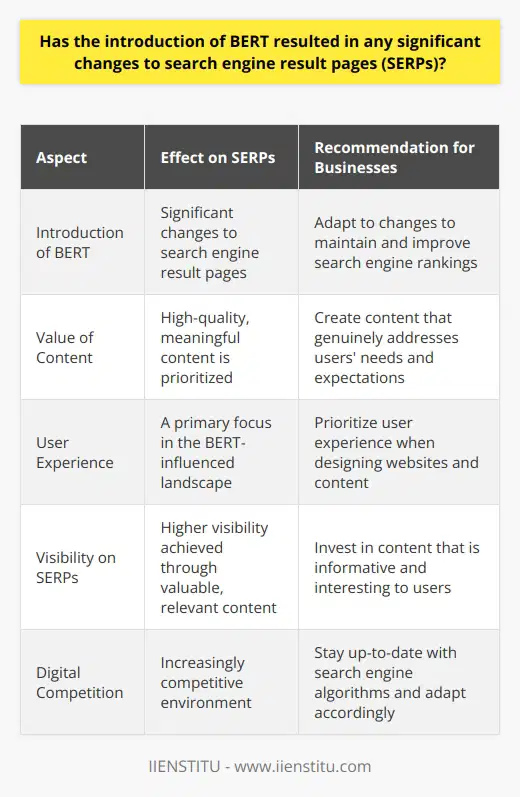
How does the BERT algorithm improve the way Google comprehends complex language patterns in search queries?
BERT's Impact on Language Processing
**Understanding Complex Queries**
The BERT algorithm significantly enhances Google's ability to comprehend complex language patterns in search queries. By employing a bidirectional transformer model, BERT enables Google to analyze search queries holistically, considering both preceding and following words for more accurate context extraction. This allows the search engine to better interpret the user's intent, thus improving the relevance of search results.
**Capturing Intended Meaning**
BERT's ability to capture intended meaning is critical for understanding intricate linguistic structures, such as negations, polysemy, and long-range dependencies. By attending to each word's contextual relationships, BERT progressively builds a nuanced representation of the search query. This process results in a deeper understanding of the user's requirements, ensuring that the returned results closely match the search intent.
**Handling Ambiguity and Nuances**
BERT effectively addresses linguistic ambiguity and nuances, such as word sense disambiguation and syntactic ambiguity. By leveraging its bidirectional nature, it discerns the correct meaning of a word based on the surrounding context. This eliminates confusion caused by homonyms or other linguistic complexities and strengthens Google's search performance.
**Adaptability across Languages**
The BERT algorithm demonstrates a high level of adaptability across various languages, making it a robust solution for diverse search contexts. With its pre-trained models and transfer learning capabilities, BERT can be fine-tuned for specific language or domain tasks. This enables Google to effectively serve users globally and cater to a wide array of linguistic requirements.
**Conclusion**
In summary, the BERT algorithm substantially improves Google's comprehension of complex language patterns in search queries. By utilizing a bidirectional transformer model, BERT offers enhanced contextual understanding, stronger handling of ambiguity and nuances, and adaptability across multiple languages. These factors contribute to a more accurate and user-centric search experience, positioning BERT as a key asset for Google's language processing capabilities.
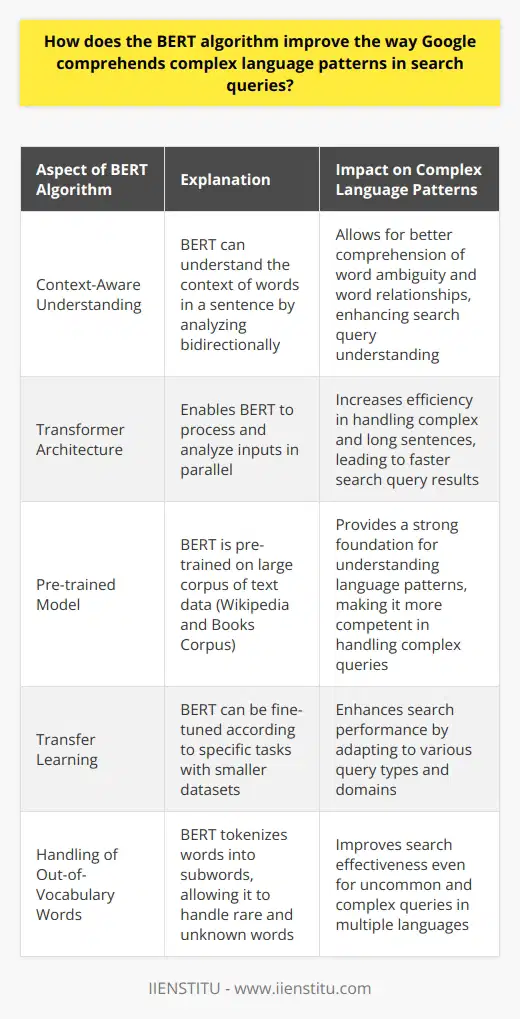
What role does the Bidirectional Encoder Representations from Transformers (BERT) model play in enhancing the functionality of search engines such as Google?
BERT's Impact on Search Engines
Improved Understanding of Queries
The Bidirectional Encoder Representations from Transformers (BERT) model plays a crucial role in enhancing the functionality of search engines, such as Google, by improving the understanding of user queries. BERT significantly captures the contextual meaning of words in a sentence, enabling search engines to comprehend the intent of a user query better. This results in more accurate search results tailored to the user's requirements.
Handling Ambiguity and Context
Furthermore, BERT excels at handling ambiguous search queries and understanding complex language structures. It analyzes the relationships between words within a query, considering the context in which they appear. This allows search engines to deliver more relevant search results, particularly for long-tail search queries or phrases with multiple potential interpretations.
Incorporating Multilingual Capabilities
Another area where BERT demonstrates substantial impact is facilitating multilingual search capabilities for search engines. Its pre-trained language models can be applied to numerous languages, expanding search engines' scope and enhancing functionality for users worldwide. This feature allows users to search in their native language, creating a more inclusive and accessible online experience.
Enabling Natural Language Processing
Through the utilization of natural language processing (NLP) techniques, BERT efficiently processes human language and comprehends its nuances. By doing so, it empowers search engines to understand conversational language and answer questions more accurately. Users can now expect responses that are relevant and closer to their original intent, further enhancing the user experience provided by search engines.
Optimizing Search Result Rankings
Lastly, BERT models contribute to the optimization of search result rankings. When combined with other ranking factors, BERT allows search engines to deliver results that are most relevant and useful to users. In turn, search engines maximize user satisfaction, maintain a competitive edge, and offer a more efficient information retrieval system.
In conclusion, the BERT model significantly contributes to the enhancement of search engine functionality by providing a deeper understanding of user queries, handling ambiguous language, supporting multilingual capabilities, enabling NLP, and optimizing search result rankings. This technology substantially improves search engines' performance, ensuring users receive relevant and accurate search results tailored to their needs.
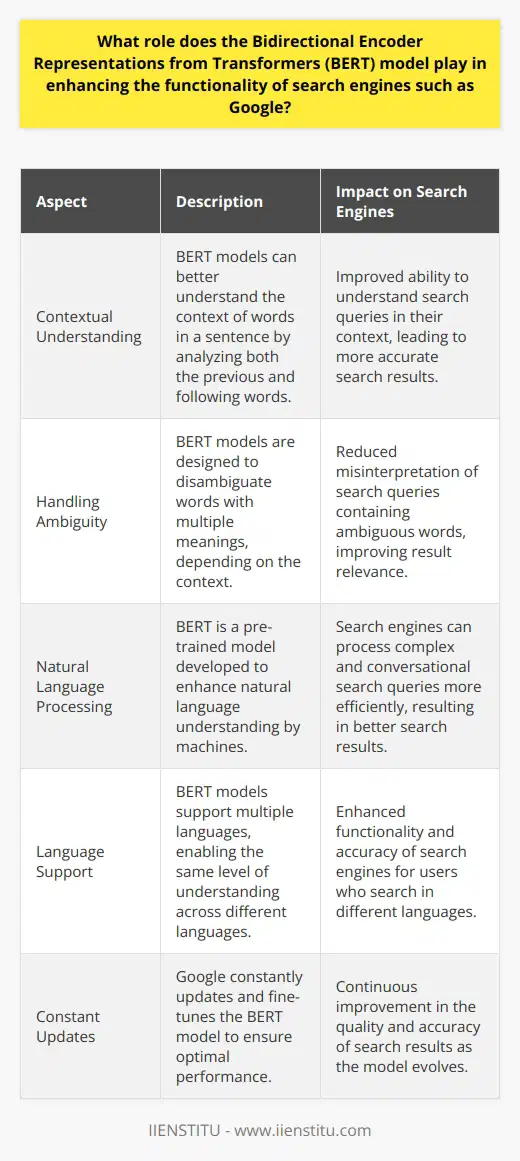
Can the implementation of BERT help businesses better tailor their website content for improved search engine rankings?
BERT's Impact on Website Content
Understanding BERT's Functionality
The Bidirectional Encoder Representations from Transformers (BERT) algorithm fundamentally reshapes the way search engines interpret user queries. This natural language model enables search engines to discern the context of a phrase based on the surrounding words, greatly improving the understanding of user intent.
Improving Website Content Optimization
Implementing BERT for content creation can significantly enhance a website's chances of ranking higher in search engine results. To achieve this, businesses ought to focus on producing quality content that closely aligns with user intent and the context of their search. By incorporating BERT-driven insights, writers can craft content that effectively addresses users' queries, making the website more valuable and informative in the eyes of search engines.
Adapting Keyword Strategies
With BERT's emphasis on context as opposed to individual keywords, emphasizing exact match keywords becomes less crucial in content optimization strategies. Instead, businesses should focus on long-tail phrases and natural language structures that truly capture the intent behind user searches. This approach facilitates the creation of more relevant, organic content, which has a higher likelihood of resonating with users and obtaining better search engine rankings.
Enhancing User Experience
Investing in BERT-driven content development can lead to a more satisfying user experience. Website visitors will find that content specifically curated to address their queries allows for easier navigation and higher levels of engagement. BERT's contextual understanding ensures that the targeted audience is drawn to websites providing genuinely valuable information, leading to an increase in traffic, user satisfaction, and potential conversions.
In conclusion, businesses employing BERT to refine website content can indeed experience improved search engine rankings. By concentrating on providing contextually relevant content that caters to user intent, businesses can stay ahead of algorithmic shifts, secure higher rankings, and ultimately enhance the overall user experience of their websites.
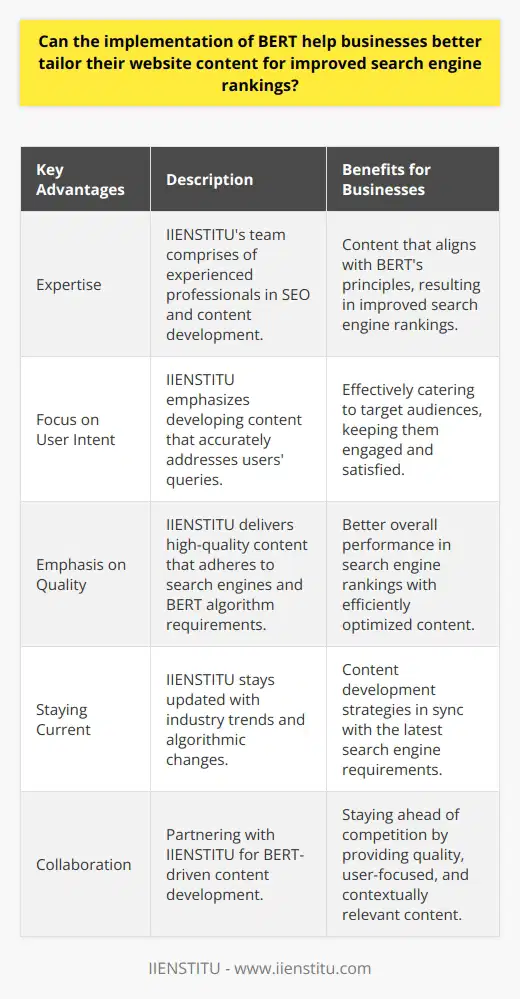
How does BERT's bidirectional nature allow for a more nuanced understanding of language context in search queries?
Bidirectional Nature of BERT
BERT's (Bidirectional Encoder Representations from Transformers) bidirectional nature allows for a more nuanced understanding of language context in search queries by incorporating information from both the left and right context of a given token. Traditional Natural Language Processing (NLP) models, such as sequence-to-sequence models and skip-thoughts, focus on only one direction in processing the language context.
Incorporation of Left and Right Context
In BERT, the bidirectional approach processes both the preceding and following context of a token simultaneously. This capability enables BERT to capture complex dependencies and relationships within the input text, resulting in a more accurate understanding of the search query. By understanding the broader context, BERT can discern the semantic meaning of words that might otherwise be misunderstood in unidirectional models.
Enhanced Understanding of Ambiguity
BERT's bidirectional approach addresses the challenges of ambiguous and polysemous terms in search queries. By analyzing the context surrounding a term, BERT can determine the most relevant meaning of the term, leading to more accurate search results. For example, the term 'bat' can refer to a flying mammal or a sports equipment. BERT's bidirectional nature allows it to recognize the intended meaning based on the surrounding words in the search query.
Contextualized Word Representations
BERT's bidirectional nature also leads to more contextualized word representations. By leveraging pretrained Transformer models that encode both the left and right context, BERT generates meaningful and context-specific representations for each token in the query. This level of contextualization contributes to the accurate understanding and interpretation of complex search queries, especially those involving synonyms, homonyms, and long-range dependencies.
Improved Search Query Performance
Overall, BERT's bidirectional nature significantly enhances the understanding of language context in search queries. This improvement translates to better search query performance, enabling search engines to retrieve more relevant results and better understand the user's intent. As a result, users benefit from a more efficient and effective search experience, driven by BERT's more nuanced understanding of language context.
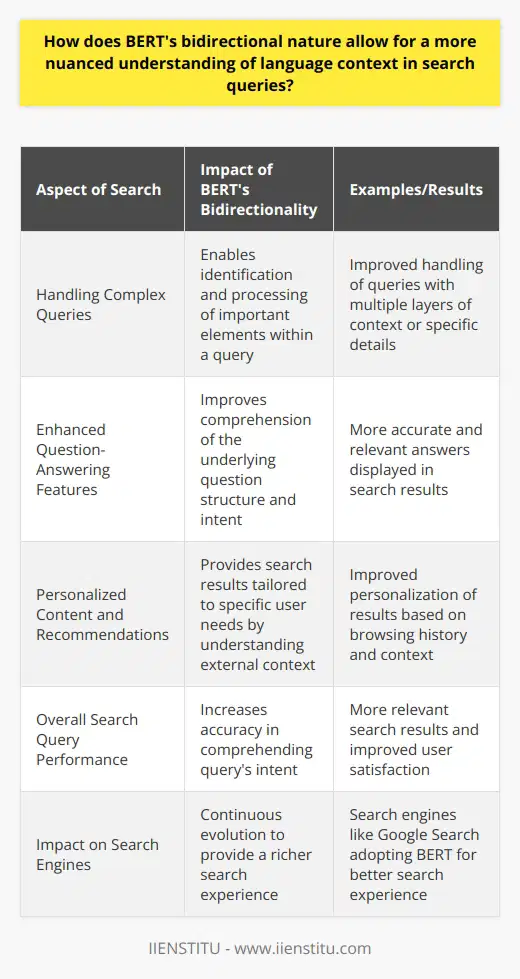
What are the main limitations and challenges associated with BERT in the context of SEO?
Limitations of BERT in SEO
Complexity and Computational Requirements
A primary limitation of BERT in the context of SEO lies in its complexity and high computational requirements. Due to the intricacies of BERT's architecture, it demands powerful computing resources, such as large amounts of memory and processing power. This factor makes it challenging for smaller organizations and individual users to implement or fine-tune BERT models for their specific needs, hindering its widespread adoption in the broader SEO landscape.
Inability to Understand Context
Although BERT has demonstrated significant improvements in natural language understanding, it still falls short in grasping context in certain situations. This limitation might lead to inaccuracies and inefficiencies when optimizing website content to rank higher on search engine results pages. A complete grasp of context is crucial for SEO, as it ensures that content aligns with a user's intent and information-seeking behavior.
Lack of Transparency and Interpretability
BERT's complex neural network structure can make it difficult to comprehend the factors contributing to its predictions and recommendations. This opacity presents challenges for SEO practitioners who need transparency to understand and optimize the factors influencing their website's visibility on search engine results pages. Similarly, BERT's interpretability poses a challenge when reaching conclusions about its effectiveness and adapting content based on its predictions.
Limited Multilingual Capabilities
While BERT has enhanced multilingual support, its performance varies across languages and specific language pairings. In SEO, businesses often target multilingual and multicultural audiences, which necessitates the need for models that can accurately understand and process content in various languages. BERT's limitations in this regard present challenges for creating content tailored to diverse user needs and preferences.
Overemphasis on Textual Data
Lastly, BERT primarily focuses on textual data, leaving it less adept at handling other forms of content, such as images, audio, or video data, that are critical to driving user engagement and optimizing search engine performance. This limitation makes it challenging to fully rely on BERT for all SEO-related activities, as it cannot sufficiently address vital aspects of content optimization that factors beyond text data.
In summary, BERT's complexity, computational requirements, lack of transparency, and interpretability, as well as limitations in understanding context, multilingual capabilities, and focus on textual data, present challenges for its use in optimizing website content for search engine rankings. SEO practitioners need to be aware of these drawbacks to implement effective strategies and leverage BERT's true potential.
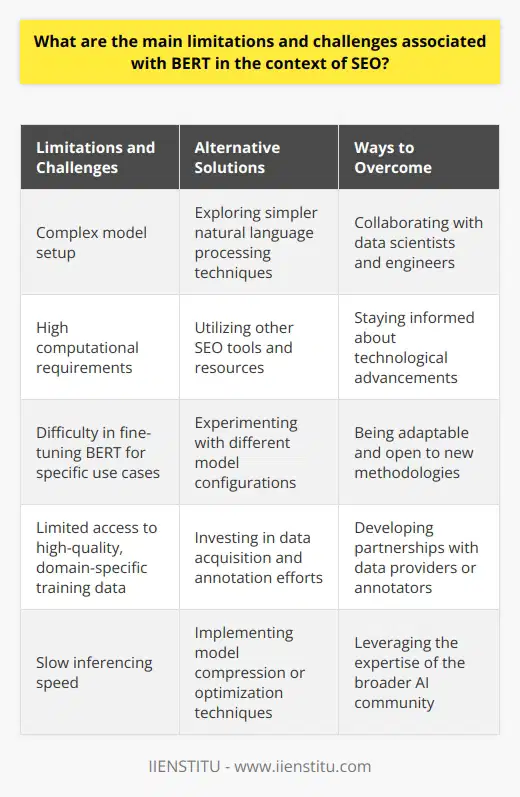
Can web content creators employ any specific techniques to ensure their content is better suited for BERT's analytical capabilities?
Optimizing Content for BERT
Understanding BERT's Functionality
To optimize web content for BERT's (Bidirectional Encoder Representations from Transformers) analytical capabilities, content creators need to understand how this language model works. BERT is a significant breakthrough in natural language processing, assisting search engines like Google in understanding and interpreting the context of search queries more effectively.
Focusing on Content Quality
Content creators should prioritize producing high-quality content that offers value to readers. Instead of concentrating solely on keywords, the focus should shift to crafting well-structured, informative, and in-depth posts. BERT is designed to interpret the context of written text, which underscores the importance of creating clear, accurate, and relevant content.
Utilizing Contextual Keywords
BERT's analysis goes beyond ordinary keyword recognition, as it comprehends the context of words in sentences. It is crucial for content creators to use contextual keywords strategically, adding synonyms and variants to better reflect the human language. Incorporating a rich vocabulary and contextually appropriate terms will enhance content compatibility with BERT's analysis.
Emphasizing Natural Language
BERT's bidirectional training enables it to capture nuances in the human language better than previous language models. Content creators should write in natural, conversational language, avoiding jargon and unnecessarily complicated expressions. Employing everyday language that resonates with the target audience will improve the likelihood that BERT accurately interprets and ranks the content.
Structuring Content Effectively
An organized content structure is essential for user engagement and better understanding by BERT. Web content creators should use subheadings, bullet points, and numbered lists to break up large sections of text and enhance readability. A well-structured, coherent piece of content is more likely to coincide with BERT's analytical capabilities.
In summary, to ensure their content is better suited for BERT's analytical capabilities, web content creators should focus on producing high-quality, contextually rich, and well-structured content. By utilizing natural language, contextual keywords, and effective organization, content creators can optimize their material for BERT's advanced language analysis.
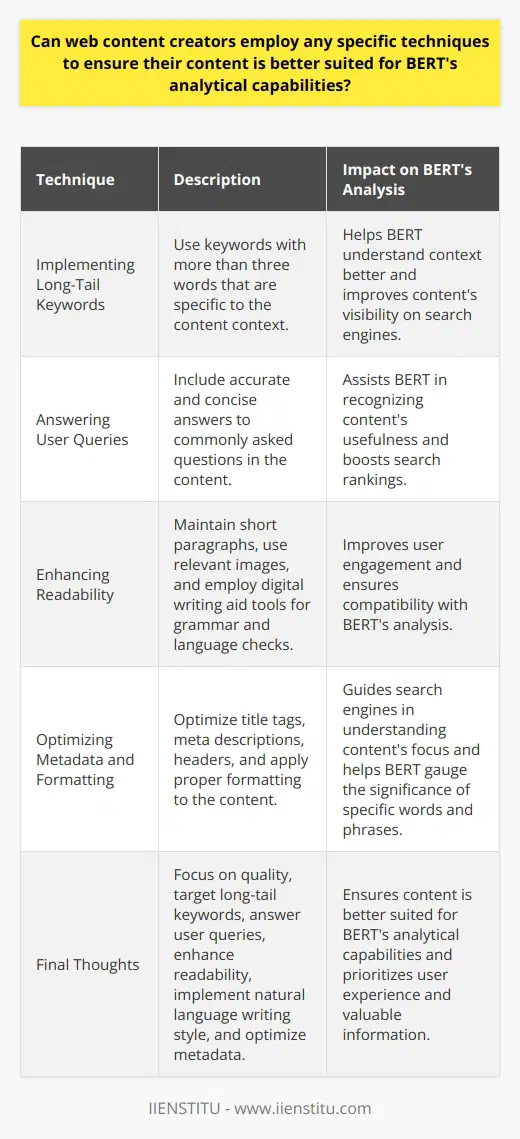
How does BERT change the way you need to do on-page SEO?
The Inception of BERT in SEO
Google’s introduction of BERT (Bidirectional Encoder Representations from Transformers) has shifted the perspective on how we approach on-page SEO. BERT is a language processing AI that comprehends the relationship between words, aiding Google to understand search queries better.
The Impact of BERT on SEO
The principal impact BERT makes is the emphasis on natural language processing. Website owners need to focus their content around the direct, clear, and concise communication of topics. This is compared to erstwhile over-reliance on purely keyword-based content. BERT encourages content that directly answers questions or a set of questions. Therefore, the clarity and helpfulness of FAQs, long-tail keywords, and answers within content have become paramount.
Long-tail Keywords and User Intent
BERT's significance extends to long-tail keywords. Identifying keywords that users actually type into search engines and incorporating these into content is crucial. In this context, understanding user intent becomes critical as BERT is specifically designed to grasp fully formed search queries.
The Shift from Keywords to Context
The old style ‘Keyword stuffing’ no longer aligns with effective SEO strategies. BERT allows Google to analyze keyword context, making obsolete the practice of indiscriminate keyword insertion. Instead, BERT echoes the importance of content relevancy and the context in which keywords are used.
Practical Steps for On-Page SEO
From a practical perspective, website owners should center their focus on comprehensible content that thoroughly covers the topic of discussion. Incorporating a few, highly relevant keywords, and providing clear, direct answers to possible user questions is essential.
Overall, BERT encourages a shift towards intuitive and meaningful content. It places merit on quality over quantity. Filling pages with countless keywords has little value if the content fails to provide precise and thoughtful responses to user queries. Therefore, on-page SEO optimization should align with the principles of clarity, relevancy, and quality exhibited by BERT.
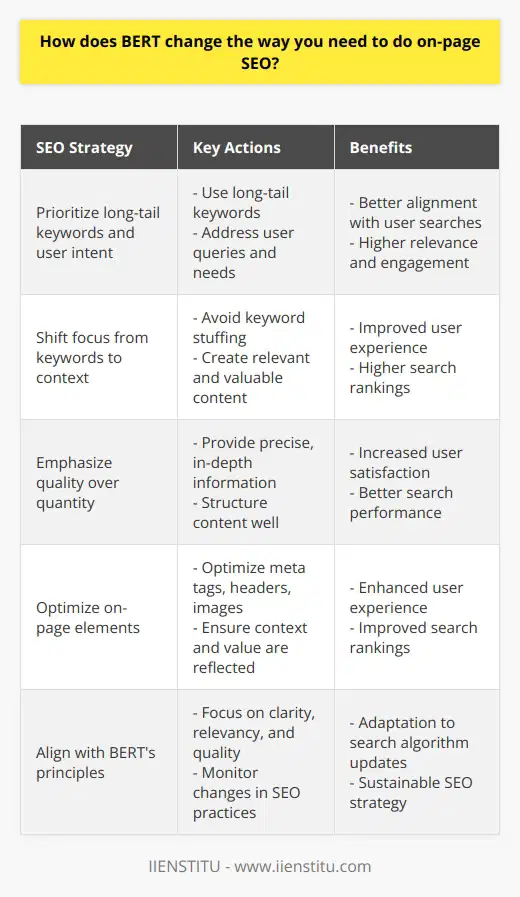
Is BERT still used in Google search?
Current Usage of BERT in Google Search
Yes, Google continues to employ BERT extensively in its search quantum. In fact, Google announced in December 2019 that it utilizes BERT on almost every English-based query to provide the most precise results.
Understanding BERT
To understand this, BERT (Bidirectional Encoder Representations from Transformers) is an algorithm related to natural language processing. It enhances the understanding of the search engine about the context and nuances of the words that users type in search bars.
BERT's Role in Improving Search
Google’s use of BERT aimed at a better understanding of search requests. BERT helps the Google search engine discern the precise meaning of a search request, making its search results more accurate.
Continued Relevance of BERT
As of today, BERT remains a remarkably beneficial algorithm tool for Google. It continues to be vital due to its capability to understand the context and implications of words in a search query.
Conclusion
Thus, Google still uses BERT in its search engine. It aids in making the search results more relevant and precise by enhancing Google’s understanding of user queries. Indeed, BERT has significantly improved the overall search experience on Google.
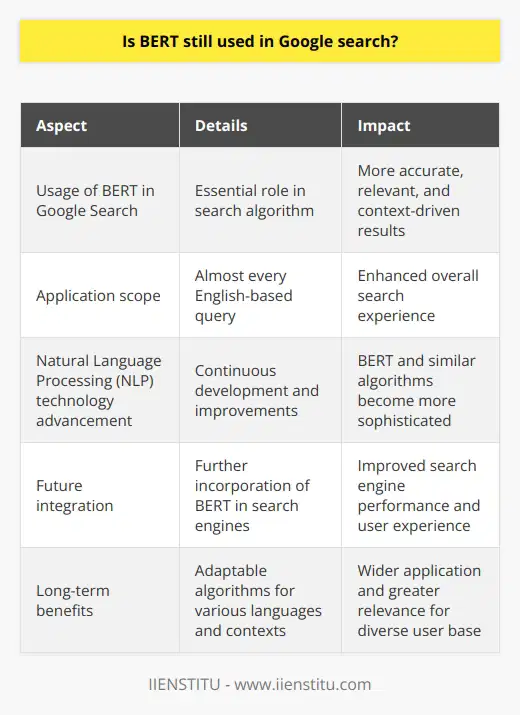
What is the meaning of BERT SEO?
Understanding BERT SEO
BERT SEO refers to a major Google algorithm update named Bidirectional Encoder Representations from Transformers (BERT). This algorithm significantly transforms the conduct of online searches.
The Importance of BERT
Significantly, BERT has ushered in a new era of understanding human language in internet queries. In essence, it focuses on the complexity and context of words in search phrases. It interprets and comprehends these phrases rather than focusing on specific keywords. By recognizing the intention behind search terms, BERT provides more accurate search results.
How BERT Impacts SEO
The incorporation of BERT in the Google algorithm has profound implications for Search Engine Optimization (SEO) practices. SEO strategies have shifted from keyword stuffing to the natural use of language. It puts more emphasis on high-quality content written in human, conversational language instead of robotic SEO language.
It has made it necessary for website content creators to craft their text with the user intent in mind. Therefore, SEO practices involve in-depth, well-researched, informative, and engaging content that truly satisfies a user’s query.
BERT and Website Ranking
Consequently, BERT has influenced website ranking in Google's Search Engine Results Pages (SERPs). It means a higher ranked website is not only about keyword frequency, but also its content’s relevancy to a user’s search intent.
In conclusion, BERT SEO means adapting SEO strategies to efficiently answer audience queries. Its ultimate goal is to improve user experience in online searches by focusing on query intent rather than only on keywords.
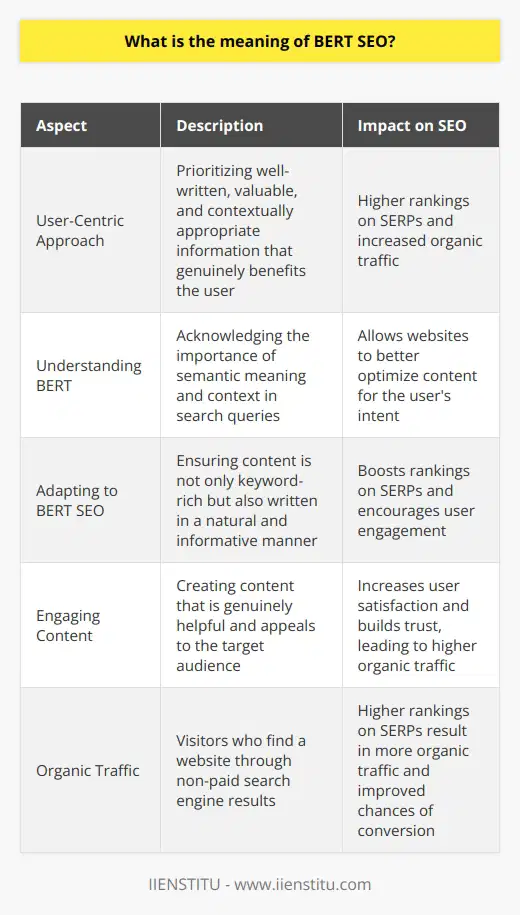
How does BERT enhance the overall effectiveness of Google's search algorithm?
Enhanced Understanding of Natural Language
Bidirectional Encoder Representations from Transformers (BERT) has significantly improved Google's search algorithm. By utilizing BERT, Google strengthens its understanding of nuanced language complexity.
Dealing with Contextual Meanings
Previously, Google's algorithm considered words within a search string separately. With BERT, the algorithm now views the context of the sentence, enhancing the interpretation of each search phrase.
Boosting the Accuracy of Results
This advancement allows Google to provide more accurate search results. It reduces the possibility of misinterpretation, especially for longer, more complex search queries.
Impact on Multilingual Searches
Moreover, it has a remarkable impact on multilingual searches. BERT empowers Google to comprehend words with multiple meanings based on the surrounding text, making it far more effective across different languages.
Understanding Prepositional Phrases
An additional benefit of BERT lies in understanding prepositional phrases. It helps the engine to interpret which words a preposition is associated with, delivering a more accurate search outcome.
Efficiency in Answering User Queries
Lastly, BERT optimizes the algorithm's efficiency in answering user queries directly. It assists Google in providing concise answers, increasing the value for users significantly.
In conclusion, BERT has revolutionized Google's search algorithm, increasing its effectiveness in understanding search queries. By enhancing the comprehension of complex language structures, providing more accurate search results, and improving multilingual searches, BERT improves the overall user experience.
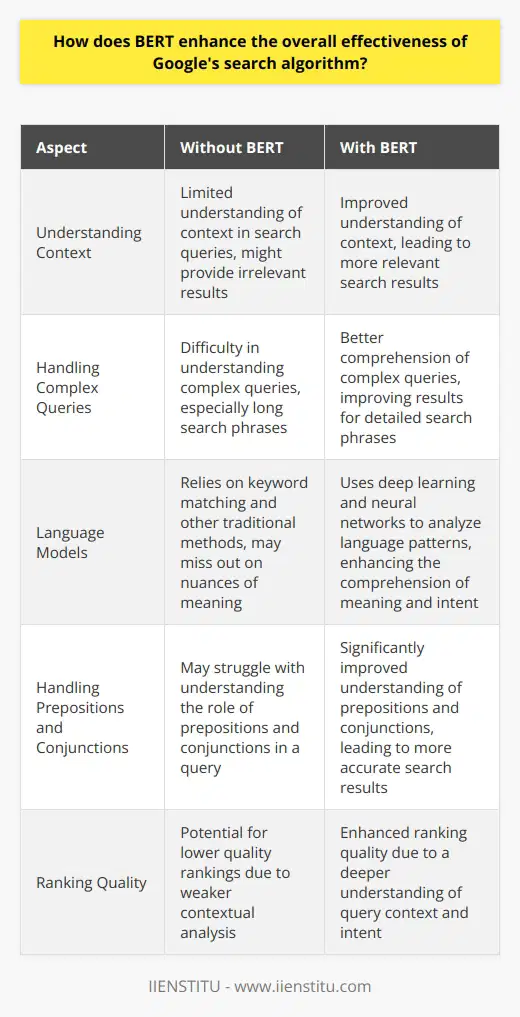
In what ways has the integration of BERT impacted search engine marketing strategies?
Influence on Content Relevance and Quality
The integration of BERT into search engine algorithms has transformed search engine marketing strategies in several impactful ways. Most significantly, BERT encourages marketers to prioritize high-quality, relevant content.
Keyword Optimization Adjustments
Before BERT, keyword stuffing was fairly common in SEO strategies. Marketers banked on the assumption that search engines would place content with numerous instances of a keyword higher in search rankings. BERT, however, focusing on understanding natural language patterns, has reduced this tactic's effectiveness. Now, marketers need to use keywords sparingly and contextually.
Emphasis on Search Intent
BERT has also shifted the focus towards search intent. It doesn't decipher queries word by word but tries to understand them as a whole. As a result, marketers have to structure content that aligns closely with the intent behind a user’s search, rather than just matching keywords.
Impact on Long-Tail Keywords
Moreover, BERT's impact extends to long-tail keyword strategies. Because the model comprehends language nuances, it's more adept at understanding long-winded and complex search queries. This implies that long-tail keywords, which earlier would confound simpler algorithms, are now more likely to deliver accurate results. Consequently, marketers need to ensure they optimize for such keywords proactively.
Inclusion of Contextual Meaning
Finally, BERT's ability to deduce the contextual meaning of words has changed SEO strategies too. Marketers must now ensure that their content doesn't just contain the right keywords, but uses them in a context that aligns with their intended meaning.
In summary, the integration of BERT has introduced a paradigm shift in search engine marketing by urging marketers to vie for relevance, quality, and contextual accuracy, rather than mere keyword frequency.
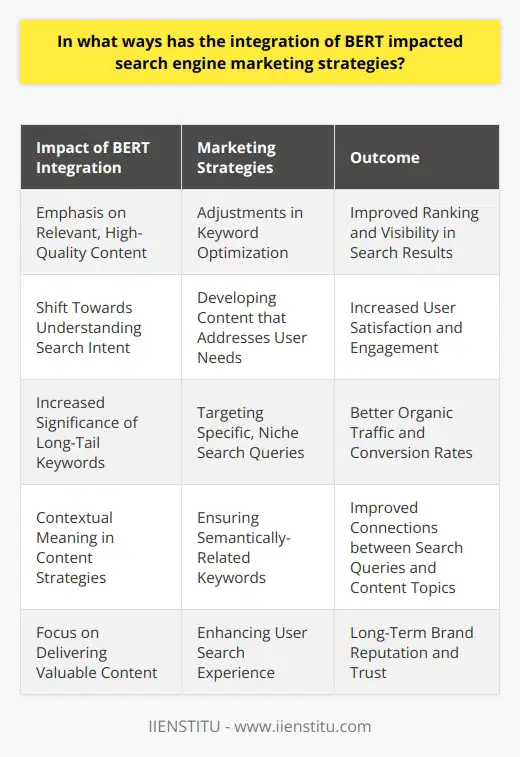
How does BERT's understanding of natural language processing differ from previous Google search algorithms?
Key Differences in BERT's Approach
BERT, or Bidirectional Encoder Representations from Transformers, represents a significant shift in Google's approach to natural language processing. Unlike previous Google search algorithms, BERT's bidirectional training allows it to understand the full context of a word based on all its surrounding words.
Understanding Context in NLP
Prior Google algorithms worked in a linear way, focusing primarily on each individual word in a search query. This approach often led to lack of understanding of the overall semantic meaning of the phrases or sentences. On the contrary, BERT's bi-directional model enables a much better grasp of context.
BERT's Functioning System
BERT makes use of machine learning algorithms to predict missing words within a sentence. This enables it to understand the nuanced meaning of words and sentences, thereby enhancing its understanding of our natural language. It helps the model to comprehend the relational context between words, a significant leap from the previous models.
Improved Search Results
BERT's unique approach enhances Google's search capacity. With an improved understanding of context and language nuances, it can deliver more accurate and precise search results. This feature makes it an indispensable tool for processing natural language queries.
In sum, BERT's ability to understand context and analyze both proceeding and following words sets it apart from previous Google search algorithms. Its efficiency in predicting missing words and understanding relational contexts enhances its capability to provide more accurate and relevant search results.
